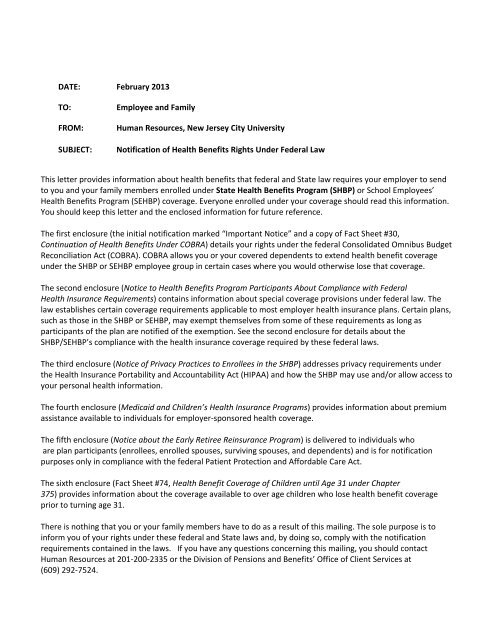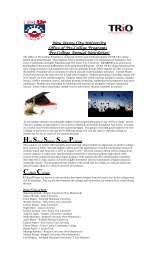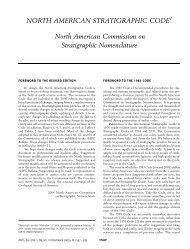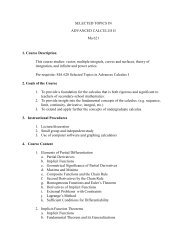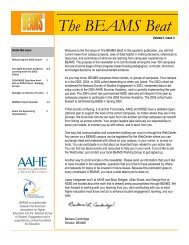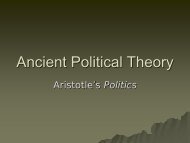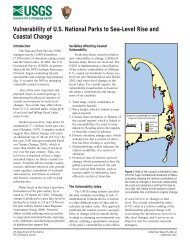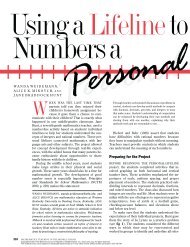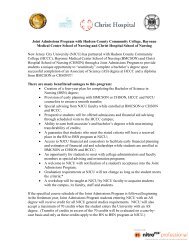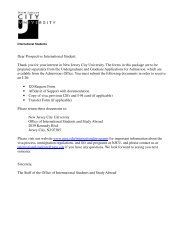HIPPA Law - New Jersey City University
HIPPA Law - New Jersey City University
HIPPA Law - New Jersey City University
- No tags were found...
You also want an ePaper? Increase the reach of your titles
YUMPU automatically turns print PDFs into web optimized ePapers that Google loves.
DATE: February 2013TO:FROM:SUBJECT:Employee and FamilyHuman Resources, <strong>New</strong> <strong>Jersey</strong> <strong>City</strong> <strong>University</strong>Notification of Health Benefits Rights Under Federal <strong>Law</strong>This letter provides information about health benefits that federal and State law requires your employer to sendto you and your family members enrolled under State Health Benefits Program (SHBP) or School Employees’Health Benefits Program (SEHBP) coverage. Everyone enrolled under your coverage should read this information.You should keep this letter and the enclosed information for future reference.The first enclosure (the initial notification marked “Important Notice” and a copy of Fact Sheet #30,Continuation of Health Benefits Under COBRA) details your rights under the federal Consolidated Omnibus BudgetReconciliation Act (COBRA). COBRA allows you or your covered dependents to extend health benefit coverageunder the SHBP or SEHBP employee group in certain cases where you would otherwise lose that coverage.The second enclosure (Notice to Health Benefits Program Participants About Compliance with FederalHealth Insurance Requirements) contains information about special coverage provisions under federal law. Thelaw establishes certain coverage requirements applicable to most employer health insurance plans. Certain plans,such as those in the SHBP or SEHBP, may exempt themselves from some of these requirements as long asparticipants of the plan are notified of the exemption. See the second enclosure for details about theSHBP/SEHBP’s compliance with the health insurance coverage required by these federal laws.The third enclosure (Notice of Privacy Practices to Enrollees in the SHBP) addresses privacy requirements underthe Health Insurance Portability and Accountability Act (HIPAA) and how the SHBP may use and/or allow access toyour personal health information.The fourth enclosure (Medicaid and Children’s Health Insurance Programs) provides information about premiumassistance available to individuals for employer-sponsored health coverage.The fifth enclosure (Notice about the Early Retiree Reinsurance Program) is delivered to individuals whoare plan participants (enrollees, enrolled spouses, surviving spouses, and dependents) and is for notificationpurposes only in compliance with the federal Patient Protection and Affordable Care Act.The sixth enclosure (Fact Sheet #74, Health Benefit Coverage of Children until Age 31 under Chapter375) provides information about the coverage available to over age children who lose health benefit coverageprior to turning age 31.There is nothing that you or your family members have to do as a result of this mailing. The sole purpose is toinform you of your rights under these federal and State laws and, by doing so, comply with the notificationrequirements contained in the laws. If you have any questions concerning this mailing, you should contactHuman Resources at 201-200-2335 or the Division of Pensions and Benefits’ Office of Client Services at(609) 292-7524.
HC-0247-1108qINFORMATION ON THECONTINUATION OF GROUP HEALTH INSURANCE COVERAGEFOR NEW EMPLOYEES AND DEPENDENTSUNDER THE PROVISIONS OF COBRAIMPORTANT NOTICECONSOLIDATED OMNIBUS BUDGET RECONCILIATION ACT (COBRA) OF 1985Dear Employee and Family Members:The federal Consolidated Omnibus Budget Reconciliation Act (COBRA) of 1985 containsa provision pertaining to the continuation of health care benefits for persons enrolled forcoverage through an employer group plan. COBRA requires that most employers sponsoringgroup health plans offer employees and their families who are losing coverage underthe employer's plan the opportunity for a temporary extension of health coverage. This coverage,called continuation coverage, would be offered at group rates plus a small administrativefee, in certain instances where coverage under the plan would otherwise end.This notice is intended to inform you of the rights and obligations under the continuationcoverage provisions of the COBRA law should you ever lose the group health coverageprovided through the <strong>New</strong> <strong>Jersey</strong> State Health Benefits Program (SHBP) or SchoolEmployees’ Health Benefits Program (SEHBP).This notice includes:• COBRA Highlights• Special Notices Concerning COBRA• Fact Sheet #30, Continuation of Health Benefits Insurance Under COBRAPlease take the time to read this notice carefully. Specific action must be taken by theemployer, the employee, and covered family members to ensure the continuity of benefitsunder COBRA.1
HC-0247-1108qCOBRA HIGHLIGHTSEMPLOYER REQUIREMENTS• Notify all newly hired employees and their dependents,within 90 days of when they are first enrolled inthe SHBP or SEHBP, of the COBRA provisions bymailing a copy of the notification letter to their home.• Notify the employee, spouse, civil union or eligibledomestic partner, and/or dependents of their rightsto purchase continued health coverage within 14days of receiving notice that there has been aCOBRA qualifying event. An application form andrate chart should be made available with the COBRANotice that gives the date of termination of coverageand the period of time over which coverage may beextended. The notification must be mailed to theemployee and family at the home address on file anda record of this notification should be maintained.EMPLOYEE REQUIREMENTS• The employee must notify the employer of a COBRAqualifying event such as divorce, legal separation,termination of a civil union or domestic partnership,or dependent child ceasing to be eligible for coverage.This must be done within 60 days of the qualifyingevent.• The employee or “qualified beneficiary” must notifythe Health Benefits Bureau of the Division ofPensions and Benefits of their decision to elect continuedcoverage by filing a COBRA application andsubmitting required premiums within 60 days ofemployer notification.SPECIAL NOTICES CONCERNING COBRA1. If coverage under the plan is modified for group employees, the coverage will also be modified in the samemanner for all COBRA eligible individuals electing continuation coverage.2. If a second qualifying event occurs during the 18-month period following the date of employee's terminationor reduction in hours, the beneficiary of that second qualifying event will be entitled to 36 months of continuationcoverage. The period, however, will be measured from the date of the first qualifying event. As anexample, John Smith terminates employment and enrolls in COBRA with husband and wife coverage for an18-month term. In the tenth month, he dies. Mrs. Smith is now eligible to continue her coverage for a total of36 months from the first COBRA event leaving her 26 months of remaining eligibility.3. COBRA continuation will terminate on the date that the enrollee first becomes covered under any other grouphealth plan as an employee or dependent unless that plan has a pre-existing condition clause. COBRA coveragecan be continued for the pre-existing condition only until the normal COBRA end date or when thepre-existing condition clause ends, whichever comes first.4. If the health plan being continued offers a choice among types of coverage, employee, spouse/partner, anddependents are each entitled to make their own decision as to these choices.5. If the employee or spouse/partner declines coverage, the spouse/partner and/or dependents may elect it forthemselves.6. COBRA subscribers are permitted to add dependents to their existing coverage within 60 days of their acquiringthose dependents (i.e., marriage, entering an eligible domestic partnership, birth, adoption, guardianship).7. COBRA enrollees have the same rights to coverage at Open Enrollment as are available to active employees.This means that you or a dependent who elected to enroll under COBRA are able to enroll in any healthplan and, if offered by your employer, the Employee Dental Plans or Employee Prescription Drug Plan coverageduring the Program’s Open Enrollment period regardless of whether you elected to enroll for the coveragewhen you first enrolled in COBRA. However, the addition of a benefit during the Open Enrollment doesnot extend the maximum COBRA coverage period. All COBRA enrollees receive Open Enrollment informationmailed directly to the address on file with the Program.8. In order to protect you and your family’s rights, you should keep your employer and the Division of Pensionsand Benefits informed of any changes in your address and the address(es) of your family members.2
HC-0262-0512 Fact Sheet #30A PUBLICATION OF THE NEW JERSEY DIVISION OF PENSIONS AND BENEFITSContinuation of Health Benefits UnderCOBRAState Health Benefits Program • School Employees’ Health Benefits ProgramINTRODUCTIONThe federal Consolidated Omnibus BudgetReconciliation Act (COBRA) of 1985 requires thatmost employers sponsoring group health plans offeremployees and their eligible dependents — alsoknown under COBRA as “qualified beneficiaries” —the opportunity to temporarily extend their grouphealth coverage in certain instances where coverageunder the plan would otherwise end. For StateHealth Benefits Program (SHBP) and SchoolEmployees’ Health Benefits Program (SEHBP) participants,COBRA is not a separate health program;it is a continuation of SHBP or SEHBP coverageunder the provisions of the federal law.ELIGIBILITY FOR COBRAEmployees enrolled in the SHBP or SEHBP maycontinue coverage under COBRA, in any plan thatthe employee is eligible for, if coverage endsbecause of a:• Reduction in working hours;• Leave of absence; or• Termination of employment for reasons otherthan gross misconduct.Note: Employees who at retirement are eligible toenroll in SHBP or SEHBP Retired Group coveragecannot enroll for health benefit coverage underCOBRA.Spouses, civil union partners, or eligible samesexdomestic partners* of employees enrolled inthe SHBP or SEHBP may continue coverage underCOBRA, in any plan that the employee is eligible for,if coverage ends because of the:• Death of the employee;• End of the employee's coverage due to areduction in working hours, leave of absence,or termination of employment for reasons otherthan gross misconduct;• Divorce or legal separation of the employeeand spouse;• Dissolution of a civil union or domestic partnership;or• Election of Medicare as the employee's primaryinsurance carrier (requires droppingthe group coverage carried as an activeemployee).Children under age 26 may continue coverageunder COBRA if the following occurs:• Death of the employee;• End of the employee's coverage due to areduction in working hours, leave of absence,or termination of employment for reasons otherthan gross misconduct; or• Election of Medicare as the employee's primaryinsurance carrier (requires dropping the groupcoverage carried as an active employee).Note: Each “qualified beneficiary” may independentlyelect COBRA coverage to continue in any or all ofthe coverage you had as an active employee ordependent (medical, prescription drug, dental,and/or vision). You and/or your dependents maychange your medical and/or dental plan when youenroll in COBRA. You may also elect to cover thesame dependents you had as an active employee, oryou can delete dependents to reduce your level ofcoverage. However, you cannot increase the level of*For more information about health benefits for domestic partners, including eligibility requirements, see Fact Sheet #71,Benefits Under the Domestic Partnership Act. For more information about health benefits for civil union partners see FactSheet #75, Civil Unions.May 2012 — Page 1 Fact Sheet #30
Fact Sheet #30A PUBLICATION OF THE NEW JERSEY DIVISION OF PENSIONS AND BENEFITSHC-0262-0512your coverage, except during the annual OpenEnrollment period, unless a qualifying event occurs(birth, adoption, marriage, civil union, eligibledomestic partnership) and you notify the Division ofPensions and Benefits’ COBRA Administrator within60 days of the qualifying event.DURATION OF COBRA COVERAGEThe length of your COBRA coverage continuationdepends on the nature of the COBRA qualifyingevent that entitled you to the coverage.• For loss of coverage due to termination ofemployment, reduction of hours, or leave ofabsence, the employee and/or dependents areentitled to 18 months of COBRA coverage.Time on leave of absence just before enrollmentin COBRA, unless under the federaland/or State Family Leave Act, counts towardthe 18-month period and will be subtractedfrom the 18 months. Time a member spends onfederal or State leave will not count as part ofthe COBRA eligibility period.• If you receive a Social Security Administrationdisability determination for an illness or injuryyou had when you enrolled in COBRA orincurred within 60 days of enrollment, you andyour covered dependents are entitled to anextra 11 months of coverage up to a maximumof 29 months of COBRA coverage. You mustprovide proof within 60 days of the disabilitydetermination from the Social SecurityAdministration or within 60 days of COBRAenrollment.• For loss of coverage due to the death of theemployee, divorce or legal separation, dissolutionof a civil union or domestic partnership,other dependent ineligibility, or Medicare entitlement,the continuation term for dependentsis 36 months.COST OF COVERAGEYou are responsible for paying the cost of your coverageunder COBRA which is the full group rate plusa 2 percent administration fee. The Division ofPensions and Benefits will bill you on a monthlybasis.EMPLOYEE / QUALIFIED BENEFICIARYRESPONSIBILITIES UNDER COBRAThe law requires that employees and/or theirdependents:• Keep your employer and the Division ofPensions and Benefits informed of anychanges to the address information of all possible“qualified beneficiaries.”• Notify your employer that a divorce, legal separation,dissolution of a civil union or domesticpartnership, or the death of the employee hasoccurred or that a covered child has reachedage 26 — notification must be given within 60days of the date the event occurred (If you donot inform your employer of the change independent status within the 60 day requirement,you may forfeit your dependent's right toCOBRA);• File a COBRA Application within 60 days of theloss of coverage or the date of the COBRANotice provided by your employer, whichever islater;• Pay the required monthly premiums in a timelymanner;• Pay premiums, when billed, retroactive to thedate of group coverage termination;• Notify the Division of Pensions and Benefits‘COBRA Administrator, in writing, of any secondqualifying event that results in an extension ofthe maximum coverage period (see “Durationof COBRA Coverage” above);• Notify the Division of Pensions and Benefits’COBRA Administrator, in writing, of a SocialSecurity Administration disability award within60 days of receipt of the award, or within 60days of COBRA enrollment (this will extendthe maximum COBRA coverage period from 18months to 29 months — see “Duration ofCOBRA Coverage” above); andFact Sheet #30 May 2012 — Page 2
HC-0262-0512 Fact Sheet #30A PUBLICATION OF THE NEW JERSEY DIVISION OF PENSIONS AND BENEFITS• Provide notice of any determination that a“qualified beneficiary” who had received a disabilityextension is no longer disabled. Thisnotice must be sent to the Division of Pensionsand Benefits’ COBRA Administrator within 30days of determination by the Social SecurityAdministration. Failure to provide timely notificationmay result in adjustments to any claimspaid erroneously.EMPLOYERRESPONSIBILITIES UNDER COBRAThe COBRA law requires employers to:• Notify employees and their dependents of theCOBRA provisions within 90 days of when theemployee and their dependents are firstenrolled in the SHBP or SEHBP by mailing anotification letter to their home;• Notify employees, their spouse or partner, andtheir children of the right to purchase continuedcoverage within 14 days of receiving notice thatthere has been a COBRA qualifying event thatcauses a loss of coverage;• Send the COBRA Notification Letter and aCOBRA Application within 14 days of receivingnotice that a COBRA qualifying event hasoccurred. The notice outlines the right to purchasecontinued health coverage, gives thedate coverage will end, and the period of timeover which coverage may be extended;• Notify the Division of Pensions and Benefitswithin 30 days of the date of an employee/dependent’s qualifying event or loss of coverage.(An employee’s loss of coverage is reportedby completing a Transmittal of DeletionsSheet. A dependent’s loss of coverage isreported through the Division’s receipt of acompleted health benefit application terminatingthe dependent’s coverage.).• Maintain records documenting their compliancewith the COBRA law.ENROLLING FOR COBRA COVERAGEThe employee and/or the dependent seekingcoverage is responsible for submitting a properlycompleted COBRA Application to the HealthBenefits Bureau of the Division of Pensions andBenefits. This application must be filed within 60days of the loss of coverage or of the date of employernotification, whichever is later. Failure to submitthe application within the time frame allowed bylaw is considered a decision not to enroll.• In considering whether to elect continuation ofcoverage under COBRA, you should take intoaccount that you cannot enroll at a later dateand that a failure to continue your group healthcoverage may affect your future rights underfederal law (see “Failure to Elect COBRACoverage”, below).• If you are retiring, you may be eligible for lifetimehealth, prescription drug, and dental coveragethrough the Retired Group of the SHBPor SEHBP. Consult your employer or theDivision of Pensions and Benefits prior to yourretirement date.FAILURE TO ELECT COBRA COVERAGEIn considering whether to elect continuation of coverageunder COBRA, a “qualified beneficiary” shouldtake into account that a failure to continue grouphealth coverage will affect future rights under federallaw.• First, you can lose the right to avoid havingpre-existing condition exclusions applied to youby other group health plans if you have morethan a 63-day gap in health coverage. The electionof continuation of coverage under COBRAmay help you to bridge such a gap (see informationabout pre-existing conditions under“Termination of COBRA Coverage” on page 4).• Second, you will lose the guaranteed right topurchase individual health insurance policiesthat do not impose pre-existing condition exclusionsif you do not continue coverage underCOBRA for the maximum time available to you.• Finally, you should take into account that youhave special enrollment rights under federallaw.You have the right to request special enrollmentin another group health plan for whichyou are otherwise eligible (such as a planMay 2012 — Page 3 Fact Sheet #30
Fact Sheet #30A PUBLICATION OF THE NEW JERSEY DIVISION OF PENSIONS AND BENEFITSHC-0262-0512sponsored by your spouse’s/partner’s employer)within 30 days of the date your groupcoverage ends. You will also have the samespecial enrollment right at the end of theCOBRA coverage period provided the continuationof coverage under COBRA is for the maximumtime available to you.AFTER YOU HAVEENROLLED IN COBRAYou should be aware of the following informationafter you have enrolled in COBRA:• Bills will be sent from the Division of Pensionsand Benefits/Health Benefits Bureau. Anybilling questions must be referred to the:COBRA AdministratorDivision of Pensions and BenefitsHealth Benefits BureauPO Box 299Trenton, NJ 08625-0299or you may call the Division’s Office of ClientServices at (609) 292-7524.• You will be billed monthly. Accounts delinquentover 45 days will be closed and insurance coverageterminated. If you do not receive amonthly bill or misplace it, contact the Office ofClient Services. It is your responsibility tomake payment on a timely basis.• Once you are enrolled in COBRA, claims arehandled just like active employee claims (i.e.using the same claim forms and procedures).However, you must indicate your status as aCOBRA participant on all claim forms (this willhelp prevent claim processing issues. AllCOBRA premiums must also be paid throughthe date of the claim in order for the claim to beprocessed). Questions about claims shouldbe directed to the insurance carriers. Thesingle exception is that vision plan claims aresent directly to the COBRA Administrator at theaddress shown above.• Plan administration under COBRA follows thesame rules as for active employees. However,all activity is processed through the COBRAAdministrator rather than the former employer.COBRA subscribers are permitted to changemedical and/or dental plans and/or add coverageduring the annual Open Enrollment period(in the fall) through the COBRA Administrator.All COBRA enrollees will receive OpenEnrollment information mailed directly to theiraddress on file with the SHBP or SEHBP.• All changes in coverage due to a "qualifyingevent" (for example: the birth of a child, a marriage,civil union, divorce, a death, etc.) mustbe made in writing to the COBRA Administratorat the address previously provided.Upon receipt of your letter, you will be sent aCOBRA change form. To increase coverage,you have 60 days from the date of the qualifyingevent to make the change. To change plans,because you have moved out of your plan'sservice area, you have 30 days to make thechange. These changes must be requestedwithin the specified time frames, otherwise theymay only be made during the Open Enrollmentperiod. You may decrease your coverage(delete a dependent) at any time.TERMINATION OF COBRA COVERAGEYour COBRA benefits under the SHBP or SEHBPwill terminate for any of the following reasons:• Your employer (or former employer) no longerprovides SHBP or SEHBP coverage to any ofits employees. In this case, your employer willgive you the opportunity to continue COBRAcoverage through their new insurance plan forthe balance of your COBRA continuation period;• You become covered under another group planas either an employee or dependent after youelect COBRA coverage (unless that plan has apre-existing condition clause). If, after enrollingin COBRA you obtain new coverage which hasa pre-existing condition clause, you may continueyour COBRA enrollment at full cost forcoverage of the condition excluded by the preexistingcondition clause. To be eligible for thecontinued COBRA coverage you will have toFact Sheet #30 May 2012 — Page 4
HC-0262-0512 Fact Sheet #30A PUBLICATION OF THE NEW JERSEY DIVISION OF PENSIONS AND BENEFITSprovide information about the pre-existing conditionclause to the COBRA administrator andonly the pre-existing condition will be covered.You will be allowed to continue yourCOBRA coverage to its normal end date orwhen the pre-existing condition clause ends,whichever comes first;• You become eligible for Medicare after youelect COBRA coverage (affects medical insurancecoverage only, does not affect dental, prescriptiondrug, or vision care coverage);• Your fail to pay your premiums; or• Your eligible coverage continuation periodends.CONVERSION OF COBRA COVERAGEThe COBRA law provides that you must be allowedto enroll in an individual, non-group policy of thesame health plan provided under the SHBP orSEHBP at the end of your COBRA enrollment period.You must complete your full coverage continuationperiod. Contact the health plan for details.A NOTE ABOUT COVERAGE FORCHILDREN AGE 26 UNTIL AGE 31The Division of Pensions and Benefits has specificguidelines about providing health coverage to childrenpast the age of 26 until age 31 due to the enactmentof Chapter 375, P.L. 2005. A child who attainsage 26 and needs continued coverage can selecteither COBRA coverage or Chapter 375 coveragefor medical benefits. Rates for COBRA coverage andChapter 375 coverage can change annually, be sureto compare the rates prior to enrolling in either program.To see a cost comparison, go to the Divisionof Pensions and Benefits Web site at:www.state.nj.us/treasury/pensions/cobrav375.shtmlChapter 375 does not cover vision or dental benefits.If your child wishes to obtain those coverages, he orshe must apply for them under COBRA.The eligibility requirements for Chapter 375 are outlinedin Fact Sheet #74, Health Benefit Coverage ofChildren Until Age 31 Under Chapter 375, which isavailable on our Web site.Note: There are no conversion provisions for prescriptiondrug or dental coverage.MORE INFORMATIONIf you need additional information about COBRA,see your Human Resources Representative orBenefits Administrator, or contact the Division ofPensions and Benefits Office of Client Services at(609) 292-7524, or send an e-mail to:pensions.nj@treas.state.nj.usThis fact sheet has been produced and distributed by:<strong>New</strong> <strong>Jersey</strong> Division of Pensions and Benefits • PO Box 295 • Trenton, <strong>New</strong> <strong>Jersey</strong> 08625-0295(609) 292-7524 • TDD for the hearing impaired (609) 292-7718URL: http://www.state.nj.us/treasury/pensions • E-mail: pensions.nj@treas.state.nj.usThis fact sheet is a summary and not intended to provide total information.Although every attempt at accuracy is made, it cannot be guaranteed.May 2012 — Page 5 Fact Sheet #30
HB-0730-0213Notice to Health Benefits Program Participants AboutCompliance with Federal Health Insurance RequirementsThis notice is being provided to inform you about State Health Benefits Program (SHBP) andSchool Employees’ Health Benefits Program (SEHBP) conformance with federal health insuranceregulations.Group health plans sponsored by State and local governmental employers, like the SHBP andSEHBP, must generally comply with federal law requirements in title XXVII of the Public HealthService Act to implement the following provisions that are contained in federal law:#1 Offer a special enrollment period to employees and dependents who do not enroll in theplan when initially eligible because they have other coverage, and who subsequentlylose that coverage;#2 Provide a minimum level of hospital coverage for newborns and mothers, generally 48hours for a vaginal delivery and 96 hours for a cesarean delivery;#3 Provide certain benefits for breast reconstruction after a mastectomy;#4 Continued coverage for up to one year for a dependent child who is covered as adependent under the plan solely based on student status, who takes a medically necessaryleave of absence from a postsecondary educational institution;#5 Provide parity in mental health benefits, that is, any dollar limitations applied to mentalhealth treatment cannot be lower than those on medical and surgical benefits.All SHBP and SEHBP plans have met or exceeded federal requirements #1 through #4 above.The State Health Benefits Commission and School Employees’ Health Benefits Commissionfiled exemptions from compliance on mental health parity (requirement #5) for 2013, as a selfinsured,non-federal governmental plan is permitted to do. As a result, visit and day limits applyto mental health benefits, except for biologically-based mental illness. Visit and day limits formental health benefits are outlined in the SHBP/SEHBP Summary Program Description, thePlan Comparison Summary, and the plan Member Handbooks.
HB-0626-0112NOTICE OF PRIVACY PRACTICES TO ENROLLEES IN THESTATE HEALTH BENEFITS PROGRAM ANDSCHOOL EMPLOYEES’ HEALTH BENEFITS PROGRAMTHIS NOTICE DESCRIBES HOW MEDICAL INFORMATION ABOUT YOU MAY BEUSED AND DISCLOSED AND HOW YOU CAN GET ACCESS TO THIS INFORMATION.PLEASE REVIEW IT CAREFULLY.EFFECTIVE DATE: APRIL 14, 2003.Protected Health InformationThe State Health Benefits Program (SHBP) andSchool Employees’ Health Benefits Program(SEHBP) are required by the federal HealthInsurance Portability and Accountability Act(HIPAA) and State laws to maintain the privacyof any information that is created or maintainedby the Programs that relates to your past, present,or future physical or mental health. ThisProtected Health Information (PHI) includesinformation communicated or maintained in anyform. Examples of PHI are your name, address,Social Security number, birth date, telephonenumber, fax number, dates of health care service,diagnosis codes, and procedure codes. PHIis collected by the Programs through varioussources, such as enrollment forms, employers,health care providers, federal and State agencies,or third-party vendors.The Programs are required by law to abide bythe terms of this Notice. The Programs reservethe right to change the terms of this Notice. Ifthe Programs make material changes to thisNotice, a revised Notice will be sent.Uses and Disclosures of PHIThe Programs are permitted to use and to disclosePHI in order for our members to obtainpayment for health care services and to conductthe administrative activities needed to run thePrograms without specific member authorization.Under limited circumstances, we may beable to provide PHI for the health care operationsof providers and health plans. Specificexamples of the ways in which PHI may beused and disclosed are provided below. This listis illustrative only and not every use and disclosurein a category is listed.• The Programs may disclose PHI to a doctoror a hospital to assist them in providinga member with treatment.• The Programs may use and disclose memberPHI so that our Business Associatesmay pay claims from doctors, hospitals,and other providers.• The Programs receive PHI from employers,including the member's name,address, Social Security number, and birthdate. This enrollment information is providedto our Business Associates so that theymay provide coverage for health care benefitsto eligible members.• The Programs and/or our BusinessAssociates may use and disclose PHI toinvestigate a complaint or process anappeal by a member.• The Programs may provide PHI to aprovider, a health care facility, or a healthplan that is not our Business Associate thatcontacts us with questions regarding themember's health care coverage.• The Programs may use PHI to bill themember for the appropriate premiums andreconcile billings we receive from ourBusiness Associates.• The Programs may use and disclose PHIfor fraud and abuse detection.• The Programs may allow use of PHI by ourBusiness Associates to identify and contactour members for activities relating toimproving health or reducing health carecosts, such as information about diseasemanagement programs or about health-1
elated benefits and services or abouttreatment alternatives that may be of interestto them.• In the event that a member is involved in alawsuit or other judicial proceeding, thePrograms may use and disclose PHI inresponse to a court or administrative orderas provided by law.• The Programs may use or disclose PHI tohelp evaluate the performance of ourhealth plans. Any such disclosure wouldinclude restrictions for any other use of theinformation other than for the intended purpose.• The Programs may use PHI in order toconduct an analysis of our claims data.This information may be shared with internaldepartments such as auditing or it maybe shared with our Business Associates,such as our actuaries.Except as described above, unless a memberspecifically authorizes us to do so, thePrograms will provide access to PHI only to themember, the member’s authorized representative,and those organizations who need theinformation to aid the Programs in the conductof its business (our “Business Associates"). Anauthorization form may be obtained over theInternet at: www.state.nj.us/treasury/pensionsor by sending an e-mail to:hipaaform@treas.state.nj.us. A member mayrevoke an authorization at any time.When using or disclosing PHI, the Programs willmake every reasonable effort to limit the use ordisclosure of that information to the minimumextent necessary to accomplish the intendedpurpose. The Programs maintain physical, technicaland procedural safeguards that complywith federal law regarding PHI.Member RightsMembers of the Programs have the followingrights regarding their PHI:Right to Inspect and Copy: With limitedexceptions, members have the right to inspectand/or obtain a copy of their PHI that thePrograms maintain in a designated record setwhich consists of all documentation relating tomember enrollment and the Programs’ use ofthis PHI for claims resolution. The member mustmake a request in writing to obtain access totheir PHI. The member may use the contactinformation found at the end of this Notice toobtain a form to request access.Right to Amend: Members have the right torequest that the Programs amend the PHI thatwe have created and that is maintained in ourdesignated record set.We cannot amend demographic information,treatment records or any other information createdby others. If members would like to amendany of their demographic information, pleasecontact your personnel office. To amend treatmentrecords, a member must contact the treatingphysician, facility, or other provider that createdand/or maintains these records.The Programs may deny the member's requestif: 1) we did not create the information requestedon the amendment; 2) the information is notpart of the designated record set maintained bythe Programs; 3) the member does not haveaccess rights to the information; or 4) webelieve the information is accurate and complete.If we deny the member’s request, we willprovide a written explanation for the denial andthe member's rights regarding the denial.Right to an Accounting of Disclosures:Members have the right to receive an accountingof the instances in which the Programs orour Business Associates have disclosed memberPHI. The accounting will review disclosuresmade over the past six years. We will providethe member with the date on which we made adisclosure, the name of the person or entity towhom we disclosed the PHI, a description of theinformation we disclosed, the reason for the disclosure,and certain other information. Certaindisclosures are exempted from this requirement(e.g., those made for treatment, payment orhealth benefits operation purposes or made inaccordance with an authorization) and will notappear on the accounting.2 State Health Benefits Program and School Employees’ Health Benefits Program
Right to Request Restrictions: The memberhas the right to request that the Programs placerestrictions on the use or disclosure of their PHIfor treatment, payment, or health care operationspurposes. The Programs are not requiredto agree to any restrictions and in some caseswill be prohibited from agreeing to them.However, if we do agree to a restriction, ouragreement will always be in writing and signedby the Privacy Officer. The member request forrestrictions must be in writing. A form can beobtained by using the contact information foundat the end of this Notice.Right to Request Confidential Communications:The member has the right to request thatthe Programs communicate with them in confidenceabout their PHI by using alternativemeans or an alternative location if the disclosureof all or part of that information to anotherperson could endanger them. We will accommodatesuch a request if it is reasonable, if therequest specifies the alternative means or locations,and if it continues to permit the Programsto collect premiums and pay claims under thehealth plan.To request changes to confidential communications,the member must make their request inwriting, and must clearly state that the informationcould endanger them if it is not communicatedin confidence as they requested.Questions and ComplaintsIf you have questions or concerns, please contactthe Programs using the information listed atthe end of this Notice.If members think the Programs may have violatedtheir privacy rights, or they disagree with adecision made about access to their PHI, inresponse to a request made to amend or restrictthe use or disclosure of their information, or tohave the Programs communicate with them inconfidence by alternative means or at an alternativelocation, they must submit their complaintin writing. To obtain a form for submitting a complaint,use the contact information found at theend of this Notice.Members also may submit a written complaintto the U.S. Department of Health and HumanServices, 200 Independence Avenue, S.W.,Washington, D.C. 20201.The Programs support member rights to protectthe privacy of PHI. It is your right to file a complaintwith the Programs or with the U.S.Department of Health and Human Services.Contact Office: HIPAA Privacy OfficerAddress:State of <strong>New</strong> <strong>Jersey</strong>Department of the TreasuryDivision of Pensions andBenefitsPO Box 295Trenton, NJ 08625-0295Fax: (609) 341-3412E-mail:hipaaform@treas.state.nj.usPrivacy Practices for Employees 3
HB-0730-0213Notice of AvailabilitySHBP/SEHBP Notice of Privacy PracticesTHIS NOTICE DESCRIBES HOW YOU MAY OBTAIN A COPY OF THE PLAN’S NOTICE OFPRIVACY PRACTICES, WHICH DESCRIBES THE WAYS THAT THE PLAN USES ANDDISCLOSES YOUR PROTECTED HEALTH INFORMATION.The SHBP and SEHBP (the “Plan”) provide health benefits to eligible employees and their eligibledependents as described in the summary plan description(s) for the Plan. The Plan creates,receives, uses, maintains, and discloses health information about participating employeesand dependents in the course of providing these health benefits.The Plan is required by law to provide notice to participants of the Plan’s duties and privacypractices with respect to covered individuals’ protected health information (PHI) and has doneso by providing to Plan participants a Notice of Privacy Practices, which describes the ways thatthe Plan uses and discloses PHI.The Plan’s Notice of Privacy Practices is available at the Division of Pensions and Benefits Website: www.state.nj.us/treasury/pensions/hipaa-notice.shtmlIf you have any questions about the Plan’s privacy practices, please contact your HumanResources office.
Premium Assistance Under Medicaid and the Children’s Health Insurance Program (CHIP)If you or your children are eligible for Medicaid or CHIP and you are eligible for health coveragefrom your employer, your State may have a premium assistance program that can help pay forcoverage. These States use funds from their Medicaid or CHIP programs to help people who areeligible for these programs, but also have access to health insurance through their employer. If youor your children are not eligible for Medicaid or CHIP, you will not be eligible for these premiumassistance programs.If you or your dependents are already enrolled in Medicaid or CHIP and you live in a State listedbelow, you can contact your State Medicaid or CHIP office to find out if premium assistance isavailable.If you or your dependents are NOT currently enrolled in Medicaid or CHIP, and you think you orany of your dependents might be eligible for either of these programs, you can contact your StateMedicaid or CHIP office or dial 1-877-KIDS NOW or www.insurekidsnow.gov to find out how toapply. If you qualify, you can ask the State if it has a program that might help you pay thepremiums for an employer-sponsored plan.Once it is determined that you or your dependents are eligible for premium assistance underMedicaid or CHIP, as well as eligible under your employer plan, your employer must permit you toenroll in your employer plan if you are not already enrolled. This is called a “special enrollment”opportunity, and you must request coverage within 60 days of being determined eligible forpremium assistance. If you have questions about enrolling in your employer plan, you can contactthe Department of Labor electronically at www.askebsa.dol.gov or by calling toll-free 1-866-444-EBSA (3272).If you live in one of the following States, you may be eligible for assistance paying youremployer health plan premiums. The following list of States is current as of July 31, 2012.You should contact your State for further information on eligibility –ALABAMA – MedicaidWebsite: http://www.medicaid.alabama.govPhone: 1-855-692-5447ALASKA – MedicaidWebsite: http://health.hss.state.ak.us/dpa/programs/medicaid/Phone (Outside of Anchorage): 1-888-318-8890Phone (Anchorage): 907-269-6529ARIZONA – CHIPWebsite: http://www.azahcccs.gov/applicantsPhone (Outside of Maricopa County): 1-877-764-5437Phone (Maricopa County): 602-417-5437COLORADO – MedicaidMedicaid Website: http://www.colorado.gov/Medicaid Phone (In state): 1-800-866-3513Medicaid Phone (Out of state): 1-800-221-3943FLORIDA – MedicaidWebsite: https://www.flmedicaidtplrecovery.com/Phone: 1-877-357-3268GEORGIA – MedicaidWebsite: http://dch.georgia.gov/Click on Programs, then Medicaid, then Health InsurancePremium Payment (HIPP)Phone: 1-800-869-1150
IDAHO – Medicaid and CHIPMedicaid Website: www.accesstohealthinsurance.idaho.govMedicaid Phone: 1-800-926-2588CHIP Website: www.medicaid.idaho.govCHIP Phone: 1-800-926-2588INDIANA – MedicaidWebsite: http://www.in.gov/fssaPhone: 1-800-889-9949IOWA – MedicaidWebsite: www.dhs.state.ia.us/hipp/Phone: 1-888-346-9562KANSAS – MedicaidWebsite: http://www.kdheks.gov/hcf/Phone: 1-800-792-4884KENTUCKY – MedicaidWebsite: http://chfs.ky.gov/dms/default.htmPhone: 1-800-635-2570LOUISIANA – MedicaidWebsite: http://www.lahipp.dhh.louisiana.govPhone: 1-888-695-2447MAINE – MedicaidWebsite: http://www.maine.gov/dhhs/ofi/publicassistance/index.htmlPhone: 1-800-977-6740TTY 1-800-977-6741MASSACHUSETTS – Medicaid and CHIPWebsite: http://www.mass.gov/MassHealthPhone: 1-800-462-1120MINNESOTA – MedicaidWebsite: http://www.dhs.state.mn.us/Click on Health Care, then Medical AssistancePhone: 1-800-657-3629MISSOURI – MedicaidWebsite:http://www.dss.mo.gov/mhd/participants/pages/hipp.htmPhone: 573-751-2005MONTANA – MedicaidWebsite: http://medicaidprovider.hhs.mt.gov/clientpages/clientindex.shtmlPhone: 1-800-694-3084NEBRASKA – MedicaidWebsite: www.ACCESSNebraska.ne.govPhone: 1-800-383-4278NEVADA – MedicaidMedicaid Website: http://dwss.nv.gov/Medicaid Phone: 1-800-992-0900NEW HAMPSHIRE – MedicaidWebsite:http://www.dhhs.nh.gov/oii/documents/hippapp.pdfPhone: 603-271-5218NEW JERSEY – Medicaid and CHIPMedicaid Website: http://www.state.nj.us/humanservices/dmahs/clients/medicaid/Medicaid Phone: 1-800-356-1561CHIP Website: http://www.njfamilycare.org/index.htmlCHIP Phone: 1-800-701-0710NEW YORK – MedicaidWebsite: http://www.nyhealth.gov/health_care/medicaid/Phone: 1-800-541-2831NORTH CAROLINA – MedicaidWebsite: http://www.ncdhhs.gov/dmaPhone: 919-855-4100NORTH DAKOTA – MedicaidWebsite:http://www.nd.gov/dhs/services/medicalserv/medicaid/Phone: 1-800-755-26042
OKLAHOMA – Medicaid and CHIPWebsite: http://www.insureoklahoma.orgPhone: 1-888-365-3742OREGON – Medicaid and CHIPWebsite: http://www.oregonhealthykids.govhttp://www.hijossaludablesoregon.govPhone: 1-877-314-5678PENNSYLVANIA – MedicaidWebsite: http://www.dpw.state.pa.us/hippPhone: 1-800-692-7462RHODE ISLAND – MedicaidWebsite: www.ohhs.ri.govPhone: 401-462-5300SOUTH CAROLINA – MedicaidWebsite: http://www.scdhhs.govPhone: 1-888-549-0820SOUTH DAKOTA - MedicaidWebsite: http://dss.sd.govPhone: 1-888-828-0059TEXAS – MedicaidWebsite: https://www.gethipptexas.com/Phone: 1-800-440-0493UTAH – Medicaid and CHIPWebsite: http://health.utah.gov/uppPhone: 1-866-435-7414VERMONT– MedicaidWebsite: http://www.greenmountaincare.org/Phone: 1-800-250-8427VIRGINIA – Medicaid and CHIPMedicaid Website: http://www.dmas.virginia.gov/rcp-HIPP.htmMedicaid Phone: 1-800-432-5924CHIP Website: http://www.famis.org/CHIP Phone: 1-866-873-2647WASHINGTON – MedicaidWebsite: http://hrsa.dshs.wa.gov/premiumpymt/Apply.shtmPhone: 1-800-562-3022 ext. 15473WEST VIRGINIA – MedicaidWebsite: www.dhhr.wv.gov/bms/Phone: 1-877-598-5820, HMS Third Party LiabilityWISCONSIN – MedicaidWebsite: http://www.badgercareplus.org/pubs/p-10095.htmPhone: 1-800-362-3002WYOMING – MedicaidWebsite: http://health.wyo.gov/healthcarefin/equalitycarePhone: 307-777-7531To see if any more States have added a premium assistance program since July 31, 2012, or formore information on special enrollment rights, you can contact either:U.S. Department of LaborU.S. Department of Health and Human ServicesEmployee Benefits Security Administration Centers for Medicare & Medicaid Serviceswww.dol.gov/ebsawww.cms.hhs.gov1-866-444-EBSA (3272) 1-877-267-2323, Ext. 61565OMB Control Number 1210-0137 (expires 09/30/2013)3
DEPARTMENT OF HEALTH & HUMAN SERVICESOffice of the SecretaryOffice of Consumer Informationand Insurance OversightInstructions for Delivering Required Form Notice to Plan Participants of SponsorsParticipating in Early Retiree Reinsurance Program, and Form NoticeIntroductionSponsors participating in the Early Retiree Reinsurance Program (ERRP) must provide a formnotice to plan participants notifying them that, because the sponsor is participating in the ERRPwith respect to the plan, the sponsor may use the reimbursements to reduce plan participants’premium contributions, copayments, deductibles, co-insurance, or other out-of-pocket costs, andtherefore plan participants may experience such changes in the terms and conditions of their planparticipation. Following are instructions on the manner and timing of delivering this form notice,and the form notice itself. Sponsors must use the attached form notice.To Whom Form Notice Must be DeliveredThe form notice must be delivered to all individuals who are plan participants (including enrolledspouses, surviving spouses, and dependents), and not just early retirees. The form notice mayalso be delivered to each such individual’s authorized agent.Timing of Delivering Form NoticeThe form notice must be delivered within a reasonable time after the sponsor receives its firstERRP reimbursement. A sponsor may deliver the form notice before it receives its first ERRPreimbursement.Manner of Delivering Form NoticeSponsors have a number of options for delivering the form notice. The form notice may beincluded with other plan materials delivered to plan participants. The form notice may bedelivered by U.S. mail or by courier service to each plan participant’s last known address. Asponsor generally may deliver one form notice per family, as long as the form notice is addressedto all plan participants who are family members.With respect to plan participants who are actively working, sponsors may instead send the formnotices electronically, provided these plan participants have the ability to access electronicdocuments at their regular place of work, and have access to the sponsor’s electronic informationsystem on a daily basis as part of their work duties.The initial notices to existing plan participants, and the subsequent notices to new planparticipants, may be delivered by the sponsor or by an entity contracted by the sponsor. However,it is the sponsor’s obligation to ensure that the form notices are properly delivered.Related NoticesTo the extent a sponsor’s use of ERRP reimbursement causes the benefits under, or terms of, theplan to change in such a way that notice of the change to plan participants is required under anyapplicable law (for example, under the Employee Retirement Income Security Act), the sponsoris required to comply with such applicable law.
NOTICE ABOUT THEEARLY RETIREE REINSURANCE PROGRAMYou are a plan participant, or are being offered the opportunity to enroll as a planparticipant, in an employment-based health plan that is certified for participation inthe Early Retiree Reinsurance Program. The Early Retiree Reinsurance Program isa Federal program that was established under the Affordable Care Act. Under theEarly Retiree Reinsurance Program, the Federal government reimburses a plansponsor of an employment-based health plan for some of the costs of health carebenefits paid on behalf of, or by, early retirees and certain family members of earlyretirees participating in the employment-based plan. By law, the program expireson January 1, 2014.Under the Early Retiree Reinsurance Program, your plan sponsor may choose to useany reimbursements it receives from this program to reduce or offset increases inplan participants’ premium contributions, co-payments, deductibles, co-insurance,or other out-of-pocket costs. If the plan sponsor chooses to use the Early RetireeReinsurance Program reimbursements in this way, you, as a plan participant, mayexperience changes that may be advantageous to you, in your health plan coverageterms and conditions, for so long as the reimbursements under this program areavailable and this plan sponsor chooses to use the reimbursements for this purpose.A plan sponsor may also use the Early Retiree Reinsurance Programreimbursements to reduce or offset increases in its own costs for maintaining yourhealth benefits coverage, which may increase the likelihood that it will continue tooffer health benefits coverage to its retirees and employees and their families.If you have received this notice by email, you are responsible for providing a copyof this notice to your family members who are participants in this plan.
HO-0764-1012 Fact Sheet #74A PUBLICATION OF THE NEW JERSEY DIVISION OF PENSIONS AND BENEFITSHEALTH BENEFIT COVERAGE OF CHILDREN UNTIL AGE 31UNDER CHAPTER 375, P.L. 2005State Health Benefits Program • School Employees’ Health Benefits ProgramCOVERAGE FOR CHILDRENUnder the State Health Benefits Program (SHBP) orthe School Employees’ Health Benefits Program(SEHBP) an eligible “child” is defined as a subscriber’schild under age 26. Health benefits coveragefor children usually ends as of December 31 of theyear in which the child turns age 26.CHAPTER 375 CHILDRENUnder the provisions of Chapter 375, P.L. 2005, asamended by Chapter 38, P.L. 2008, certain over agechildren may be eligible for coverage until age 31.This includes a child by blood or law who:• is under the age of 31;• unmarried;• has no dependent(s) of his or her own;• is a resident of <strong>New</strong> <strong>Jersey</strong> or is a full-time studentat an accredited public or private institutionof higher education; and• is not provided coverage as a subscriber,insured, enrollee, or covered person under agroup or individual health benefits plan, churchplan, or entitled to benefits under Medicare.ENROLLING FOR CHAPTER 375 COVERAGEA covered employee (from a SHBP or SEHBP participatingemployer) or retiree may enroll an over agechild who is Chapter 375 eligible and 30 years of ageor younger at the following times:• within 30 days prior to December 31 of the yearthe child reaches age 26 with coverage effectivethe following January 1;• if, within 30 days of coverage loss, the coveredemployee provides proof of loss of other groupcoverage (HIPAA) for the Chapter 375 eligibleover age child with coverage effective the datethat the prior coverage was terminated; or• during the month of October of each year if theover age child meets the eligibility requirementsof Chapter 375 as outlined above with coverageeffective the following January 1.REQUIRED DOCUMENTATIONA completed Chapter 375 Application forCoverage, a photocopy of the over age child’s birthcertificate, and a photocopy of the front page of thechild’s most recently filed federal tax return (Form1040). You may black out all financial information andall but the last four digits of any Social Security numbers.If the child resides outside of the State of<strong>New</strong> <strong>Jersey</strong>, documentation of full-time studentstatus must be submitted.If applicable, documentation of the proof of loss ofother coverage (HIPAA) is also required whenenrolling for this extended coverage. If the over agechild is adopted, a step child, or a legal ward, supportingdocumentation is required, if not already onfile. For a description of the required documentation,see the Division of Pensions and Benefits Web site at:www.state.nj.us/treasury/pensions/health-benefits.shtmlNOTE: The application and required documentationmust be submitted to the Division ofPensions and Benefits on or before the child’s30th birthday.PLAN SELECTIONUnder Chapter 375, an over age child does not haveany choice in the selection of benefits but is enrolledfor coverage in exactly the same plan or plans (medicaland/or prescription drug) that the covered parenthas selected. There is no provision for eligibility fordental or vision benefits (see “A Note About COBRACoverage” on page 2).COVERAGE COSTSWhen Chapter 375 coverage is elected the coveredparent will be billed directly for the cost; therefore thecovered parent is held responsible for the payment ofthe Chapter 375 coverage.October 2012 — Page 1 Fact Sheet #74
Fact Sheet #74A PUBLICATION OF THE NEW JERSEY DIVISION OF PENSIONS AND BENEFITSHO-0764-1012Chapter 375 Rate Charts showing the premiumamounts for all health benefit plans are available fromyour employer, by contacting the Division of Pensionsand Benefits, or over the Internet at: www.state.nj.us/treasury/pensions/health-benefits.shtmlEnrollment of over age children for coverage underChapter 375 is voluntary.The provisions of Chapter 375do not require an employer to pay all or any part of thecost of coverage for any election of this coverage.WHEN COVERAGE ENDSCoverage for an enrolled over age child will endwhen the child no longer meets any one of the eligibilityrequirements listed above, or when the coveredparent’s coverage ends (for example: termination ofemployment, divorce, or death of the covered parent).Coverage may also be terminated in the eventof non-payment of the required premiums.Chapter 375 coverage ends on the first of the monthfollowing the event or the date that makes the childineligible. To terminate coverage, complete theChapter 375 Application and check the box in sectionfour. A letter signed by the covered parent is alsoacceptable.NOTE: Written requests on the bill for termination willnot be accepted.The termination date is dependent upon the following:• Timeliness of receipt of written request;• Date of service of last paid claim; and• Non-payment of premiums.Terminations will not be retroactive unless the requestis received within 30 days of the date requested andno claims have been paid for services after that date.Otherwise, the coverage will be terminated timely.There is no provision for the continuation of groupcoverage under COBRA for a child due to the loss ofChapter 375 coverage. Nor is there any provision forconversion to non-group coverage.A NOTE ABOUT COBRA COVERAGEThe year in which your covered child turns age 26,you will receive a COBRA notification letter prior tothe termination of the child’s coverage, which isrequired by federal law. The notice outlines the rightto purchase continued health coverage, gives thedate coverage will end, and the period of time overwhich coverage may be extended (usually 36months). Rates for Chapter 375 coverage andCOBRA coverage can change annually, be sure tocompare the rates prior to enrolling in either program.To see a cost comparison, go to the Division ofPensions and Benefits Web site at: www.state.nj.us/treasury/pensions/cobrav375.shtmlChapter 375 does not cover vision and dental benefits.If your child wishes to obtain those coverages heor she must apply for them under COBRA.ADDITIONAL INFORMATIONFor a Chapter 375 Rate Chart, a Chapter 375Application for Coverage, or if you have additionalquestions about Chapter 375 eligibility or coverage,see your employer’s Benefits Administrator, or theChapter 375 information at the Division of Pensionsand Benefits Web site at: www.state.nj.us/treasury/pensions/health-benefits.shtmlIf you need information concerning COBRA coverage,see Fact Sheet #30, Continuation of HealthBenefits Insurance Under COBRA, available fromyour employer or the Web site listed above.You may also contact the Division of Pensions andBenefits’ Office of Client Services at (609) 292-7524,or e-mail the Division at:pensions.nj@treas.state.nj.usThis fact sheet has been produced and distributed by:<strong>New</strong> <strong>Jersey</strong> Division of Pensions and Benefits • PO Box 295 • Trenton, <strong>New</strong> <strong>Jersey</strong> 08625-0295(609) 292-7524 • TDD for the hearing impaired (609) 292-7718URL: http://www.state.nj.us/treasury/pensions • E-mail: pensions.nj@treas.state.nj.usThis fact sheet is a summary and not intended to provide total information.Although every attempt at accuracy is made, it cannot be guaranteed.Fact Sheet #74 October 2012 — Page 2
HB-0327-0113pCERTIFICATE OF GROUP HEALTH PLAN COVERAGE1. Date of this certificate: _________________________________________________________________2. Name of participant: ___________________________________________________________________3. Name of group health plan: _____________________________________________________________4. Identification number of participant: _______________________________________________________5. Name of any dependents to whom this certificate applies: ________________________________________________________________________________________________________________________6. Name, address, and telephone number of issuer responsible for providing this certificate:____________________________________________________________________________________________________________________________________________________________________________________________________________________________________________________________________________________________________________________________________________7. For further information, call: _____________________________________________________________8. If the individual(s) identified in line 2 and line 5 has at least 18 months of creditable coverage (disregardingperiods of coverage before a 63-day break), check here _____ and skip lines 9 and 10.9. Date waiting period or affiliation period (if any) began: ________________________________________10. Date coverage began: _________________________________________________________________11. Date coverage ended: _________________________________________________________________(or check if coverage is continuing as of the date of this certificate _____ ).NOTE: Separate certificates will be furnished if information is not identical for the participant and each covered dependent.Statement of HIPAA Portability RightsIMPORTANT - KEEP THIS CERTIFICATE. This certificate is being provided to you in compliance with therequirements of the Federal Health Insurance Portability and Accountability Act (HIPAA) of 1996. It providesevidence of your prior health coverage in the <strong>New</strong> <strong>Jersey</strong> State Health Benefits Program or School Employees’Health Benefits Program.You may need to furnish this certificate to your new insurer if you become eligible undera group health plan that excludes coverage for certain medical conditions that you have before you enroll. Thiscertificate may need to be provided if medical advice, diagnosis, care, or treatment was recommended or receivedfor the condition within the 6-month period prior to your enrollment in the new plan. If you become coveredunder another group health plan, check with the plan administrator to see if you need to provide this certificate. Youmay also need this certificate to buy, for yourself or your family, an insurance policy that does not exclude coveragefor medical conditions that are present before you enroll.Preexisting Condition Exclusions — Some group health plans restrict coverage for medical conditions presentbefore an individual’s enrollment. These restrictions are known as “preexisting condition exclusions.” A preexistingcondition exclusion can apply only to conditions for which medical advice, diagnosis, care, or treatment wasrecommended or received within the 6 months before your “enrollment date.” Your enrollment date is your first dayof coverage under the plan, or — if there is a waiting period — the first day of your waiting period (typically, yourfirst day of work). In addition, a preexisting condition exclusion cannot last for more than 12 months after yourenrollment date (18 months if you are a late enrollee). Finally, a preexisting condition exclusion cannot apply topregnancy and cannot apply to a child who is enrolled in health coverage within 30 days after birth, adoption, orplacement for adoption.(Continued on back)
HB-0327-0113pStatement of HIPAA Portability Rights (Continued)If a plan imposes a preexisting condition exclusion, the length of the exclusion must be reduced by the amount ofyour prior creditable coverage. Most health coverage is creditable coverage, including: group health plan coverage,COBRA continuation coverage, coverage under an individual health policy, Medicare, Medicaid, StateChildren’s Health Insurance Program (SCHIP), and coverage through high-risk pools and the Peace Corps. Notall forms of creditable coverage are required to provide certificates like this one. If you do not receive a certificatefor past coverage, talk to your new plan administrator.You can add up any creditable coverage you have, including the coverage shown on this certificate. However, ifat any time you went for 63 days or more without any coverage (called a break in coverage) a plan may not haveto count the coverage you had before the break.• Therefore, once your coverage ends, you should try to obtain alternative coverage as soon as possibleto avoid a 63-day break. You may use this certificate as evidence of your creditable coverage toreduce the length of any preexisting condition exclusion if you enroll in another plan.Right to Get Special Enrollment in Another Plan — Under HIPAA, if you lose your group health plan coverage,you may be able to get into another group health plan for which you are eligible (such as a spouse’s plan),even if the plan generally does not accept late enrollees, if you request enrollment within 30 days. (Additionalspecial enrollment rights are triggered by marriage, birth, adoption, and placement for adoption.)• Therefore, once your coverage ends, if you are eligible for coverage in another plan (such as a spouse’splan), you should request special enrollment as soon as possible.Prohibition Against Discrimination Based on a Health Factor — Under HIPAA, a group health plan may notkeep you (or your dependents) out of the plan based on anything related to your health. Also, a group health planmay not charge you (or your dependents) more for coverage, based on health, than the amount charged asimilarly situated individual.Right to Individual Health Coverage — Under HIPAA, if you are an “eligible individual,” you have a right to buycertain individual health policies (or in some states, to buy coverage through a high-risk pool) without a preexistingcondition exclusion. To be an eligible individual, you must meet the following requirements:• You have had coverage for at least 18 months without a break in coverage of 63 days or more;• Your most recent coverage was under a group health plan (which can be shown by this certificate);• Your group coverage was not terminated because of fraud or nonpayment of premiums;• You are not eligible for COBRA continuation coverage or you have exhausted your COBRA benefits(or continuation coverage under a similar state provision); and• You are not eligible for another group health plan, Medicare, or Medicaid, and do not have any otherhealth insurance coverage.The right to buy individual coverage is the same whether you are laid off, fired, or quit your job.• Therefore, if you are interested in obtaining individual coverage and you meet the other criteria to bean eligible individual, you should apply for this coverage as soon as possible to avoid losing youreligible individual status due to a 63-day break.State Flexibility — This certificate describes minimum HIPAA protections under federal law. States may requireinsurers and HMOs to provide additional protections to individuals in that state.For More Information — If you have questions about your HIPAA rights, you may contact your state insurancedepartment or the U.S. Department of Labor, Employee Benefits Security Administration (EBSA) toll-free at 1-866-444-3272 (for free HIPAA publications ask for publications concerning changes in health care laws). Youmay also contact the federal Centers for Medicare and Medicaid Services publication hotline at 1-800-633-4227(ask for Protecting Your Health Insurance Coverage). These publications and other useful information are alsoavailable on the Internet at: www.dol.gov/ebsa, the DOL’s interactive Web pages - Health E-laws, or at:www.cms.hhs.gov/hipaa
HB-0327-0113pINSTRUCTIONS FOR COMPLETING THE HIPAA CERTIFICATE OF COVERAGEThe completion of a Certificate of Coverage is a requirement of the federal Health Insurance Portability andAccountability Act (HIPAA). HIPAA requires that group health plans provide a Certificate of Coverage automaticallyto any covered employee or dependent who loses group coverage after June 1, 1997. In the State HealthBenefits Program (SHBP) or School Employees’ Health Benefits Program (SEHBP), the participatinglocal employer or State payroll office has the responsibility for providing required Certificates of Coverage.ITEM 1:ITEM 2:ITEM 3:ITEM 4:ITEM 5:ITEM 6:Insert the date you are completing the form.Insert the full name of the covered participant requesting the Certificate of Coverage.Insert the name of the SHBP or SEHBP health plan that covered the participant.Insert the participant’s SHBP or SEHBP health coverage identification number.Insert the full name(s) of any dependent(s) covered under the participant’s health coverage at thetime of termination of coverage. Indicate any dependent(s) who did not have coverage for the sametime period as the participant. For example, if the participant was covered for over 18 months, butthe dependent(s) was only covered for eight months, indicate that on the form.In most cases, the name, address, and phone number of the employer issuing the certificate will beinserted here. If the Certificate of Coverage is being issued subsequent to the termination of coverageunder COBRA, the SHBP/SEHBP COBRA Administrator will complete this form and insert itsidentifying information here.ITEM 7: Insert the same telephone number indicated in Item 6.ITEM 8:Show the period of time for which the participant is entitled to credit under his/her new plan’s preexistingcondition exclusion provisions (if any). This includes the period of time the participant wascovered under the SHBP/SEHBP plan, either as an active employee or on any other basis, includingCOBRA. If the participant went 63 or more consecutive days without health coverage, any coveragethat the participant had before the significant break in coverage is ignored. A waiting period beforean employee is eligible for plan coverage does not count either as part of a significant break incoverage or in an individual’s total of creditable coverage. You must also show the period of coveragefor dependent(s) if different from the participant. Do this in Item 4. The longest pre-existingcondition period under HIPAA is 18 months, therefore if the participant was covered by a SHBP/SEHBP plan for at least 18 months, that is all that needs to be reported here. If the coverage periodwas shorter than 18 months, the following must be reported in Items 9 through 11:• the first day of the waiting period completed by the participant, if any (this is the periodbetween the date of hire and the start of coverage);• the first day of the participant’s creditable coverage;• the last day of the participant’s creditable coverage.ITEM 9:ITEM 10:ITEM 11:Insert the day the waiting period (if any) began. This would be the first day at work for a new employeewhose coverage does not start immediately.Insert the date coverage began.Insert the date coverage ended. If you have confirmation that coverage under COBRA or the SHBPor SEHBP Retired Group is continuing, then check the coverage continuing block. Do not check thecoverage continuing block if you are not certain that a COBRA or Retired Group application hasbeen initiated and the enrollment processed.


